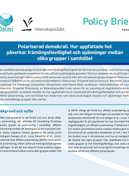This policy brief summarizes a research project that aims to create an understanding of how contemporary racist and xenophobic ideas are shaped and distributed in Sweden. The project examined how these perceptions are shaped by actors in three social fields; (1) the general public, (2) opinion journalism and (3) politics.
The policy brief analyzes how; 1) the internet strengthens the visibility and mobilization opportunities of racist actors; 2) racism is shaped and distributed in everyday communication on social media; and 3) how xenophobic and racist elements are gradually normalized by established public actors. The studies are based on both quantitative and qualitative methods for data collection and analysis.
Some conclusions:
- By writing and recasting news from established sources, racist and xenophobic actors can produce and, via social media platforms such as Facebook, distribute large amounts of material with relatively small resources.
- Social media is used as a mobilization tool by racist and xenophobic actors. However, involvement on the internet - usually in the form of visibility on social media - rarely leads to long-term concrete collective action.
- Subtle and implicit statements and ideas marketed by leading writers in newspapers and by elected politicians on social media platforms help to normalize xenophobic and racist thoughts and opinions.
- In addition to serving as a place for the expression and spread of xenophobia and racism, the comments on social media can provide a breeding ground for racist communication that is enhanced through user-interactivity.
- Tech-companies, such as Facebook, do not live up to their demands for moderation of racist content.
The author of this policy brief is Mattias Ekman, associate professor of media and communication science at Stockholm University.
The policy brief is only available in Swedish. Please contact Delmi if you are interested in finding out more.
Picture by Robin Worrall from Unplash.

